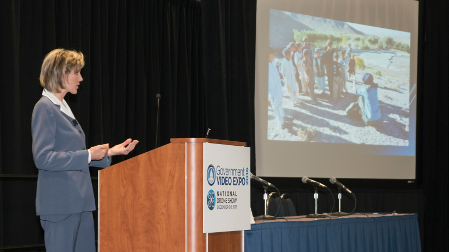GV Expo: Reporting From the Front Lines
WASHINGTON--War correspondent Gail McCabe took the stage at Wednesday’s Government Video Expo to share her personal stories and challenges operating as a one-woman band. As a videographer, reporter, editor and producer, she spent time with our armed forces over three decades. McCabe said her experiences fell under what she called “the three Cs: combat, culture and communication.”

McCabe opened her session, coincidently on Pearl Harbor Day, with a statistic that put things into perspective. Only one half of 1 percent of Americans served in Iraq and Afghanistan. It was important to her to be able to tell the stories, to help others see war “up close and personal.” She has traveled around the world to cover war zones, humanitarian crises and peace-keeping efforts.
Overall, McCabe took 13 trips to Iraq and 17 to Afghanistan. She said that, while many of the situations she experienced might be similar, the circumstances were all unique. She described arriving in Baghdad in April 2003 under cover of darkness, with tired troops who had been traveling much longer than her that day. It was a hot landing on a Boeing C-17. A "hot landing" means landing where the enemy may be operating, so no lights, staying out of the way of possible attack until the last moment, then straight in and out again as quickly as possible. When the occupation was beginning in Iraq, there were still enemies taking pot shots. The airport was seen as a potential attack zone at the time. McCabe had her backpack filled with tapes, batteries, microphones, battery charger, power cords, adapters, lenses, Sony DVCAM camcorder, tripod and other miscellaneous items. Welcome to Baghdad Airport.
Hitching a ride into downtown Baghdad the next day, McCabe happened upon a job fair where Americans were hiring locals as translators if they could read and speak English. To the disbelief of the Iraqis, the Americans handling the interviews were asking those who qualified to understand that payment wouldn’t be for several weeks. Trust in a foreign government was difficult for a struggling people. And unfortunately, the large amounts of cash American troops discovered hidden by Saddam Hussein had to go through the proper channels and couldn’t be used to pay the translators.
McCabe talked about her time with Task Force 51 in Zaire (now known as the Democratic Republic of the Congo), where some 800,000 people had been executed. Camps had been set up to provide shelter, but lacked food and water and the unsanitary conditions caused a cholera epidemic. Her mission was to cover the soldiers as they installed water purification units. There were a number of organizations providing aid, non-governmental as well as multinational military, and technically, while history says there was someone giving orders, from McCabe’s perspective it didn't seem like anyone was in charge.
She was taking pictures when a man approached her shaking his finger. He was upset and expected her to pay him for his picture. Sensing his anger, McCabe was quickly surrounded and protected by military police armed with M16s. It is customary in some parts of Africa to expect to be paid when someone takes your picture, which McCabe didn't know at the time. When she offered to interview him about the plight of his people, his anger seemed to dissolve. She said she learned a valuable lesson in respecting cultural differences."
McCabe was injured twice. The first time was in January 2004, when during an ambush she was shot in the back. Her vest stopped the bullet from penetrating. The second injury occurred in March 2014 at a clinic outside Kandahar Air Field during a military medical mission to treat locals. The combat medics, who were female, had to be culturally sensitive in treating injured Afghan men. A truck rammed into the clinic carrying what she later found out was the equivalent of a 4,000-pound TNT bomb. The adrenaline kicked in and she was able to get footage and document those who were saved and those who didn’t make it, all while sporting an injury to her arm from flying debris that exposed bone. McCabe said every journalist wonders “when that moment comes, ‘What will I do?’ This was my moment. I had to capture the moment,” she said.
In the course of her career, McCabe went from working with two-piece tube equipment to Betacam and finally, high-definition and digital, and from tape to solid-state memory cards to making use of the internet to transmit her stories.
At the end of the session McCabe was asked what her most difficult challenge was. She replied that it was contacting family to let them know she’d been injured. She wanted them to hear from her personally that she was okay. While being treated for her gunshot wound in Iraq, it took four connections on a borrowed satellite phone to reach her husband, who was traveling on the Metro to a meeting in Washington, D.C.
Get the TV Tech Newsletter
The professional video industry's #1 source for news, trends and product and tech information. Sign up below.
